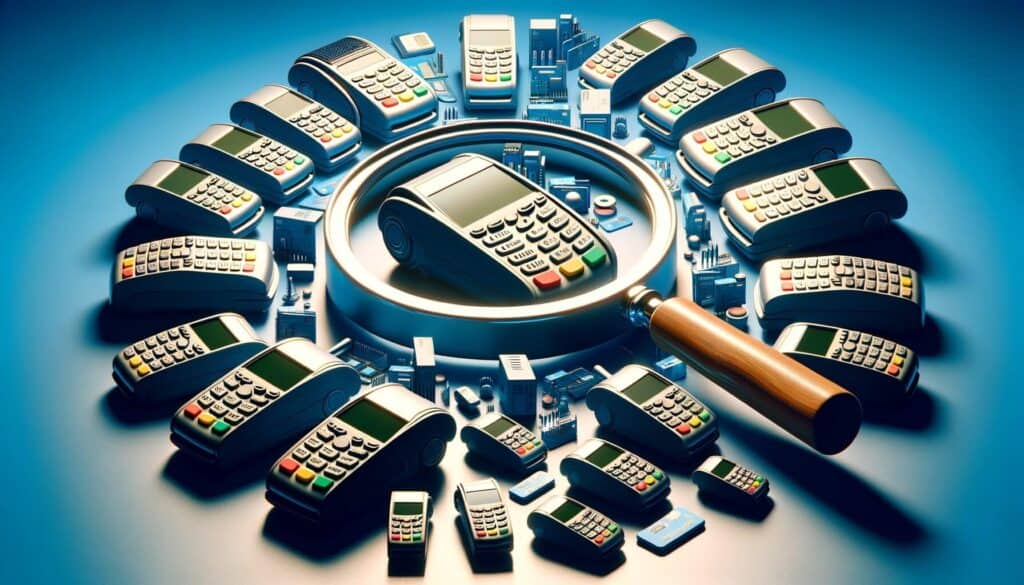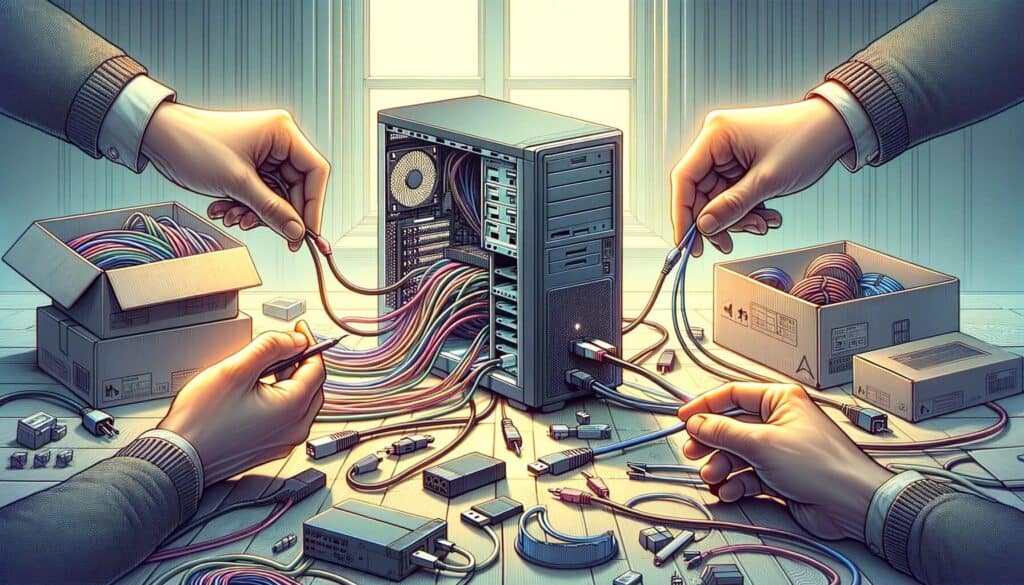
By Crystal Hopkins March 31, 2025
In today’s digital age, credit card terminals have become an essential tool for businesses of all sizes. These devices allow merchants to accept credit and debit card payments, providing convenience and flexibility to customers. However, setting up a credit card terminal can be a daunting task, especially for those who are new to the process.
In this comprehensive guide, we will walk you through the step-by-step process of setting up a credit card terminal, from choosing the right device to ensuring proper functionality and security measures.
Choosing the Right Credit Card Terminal for Your Business

Before diving into the setup process, it is crucial to choose the right credit card terminal for your business. With a wide range of options available in the market, it is essential to consider factors such as your business type, transaction volume, and budget. Here are some key points to consider when selecting a credit card terminal:
1. Determine your business needs: Assess your business requirements, such as the number of transactions you expect to process, the types of payment methods you want to accept, and any specific features you may need, such as wireless connectivity or touch screen capabilities.
2. Research different terminal types: There are various types of credit card terminals available, including countertop terminals, wireless terminals, mobile card readers, and virtual terminals. Each type has its own advantages and limitations, so it is important to research and understand which one suits your business best.
3. Consider compatibility: Ensure that the credit card terminal you choose is compatible with your existing point-of-sale (POS) system or payment processor. Compatibility issues can lead to unnecessary complications and delays in the setup process.
4. Evaluate pricing and fees: Compare the pricing and fees associated with different credit card terminals. Consider factors such as upfront costs, transaction fees, monthly fees, and any additional charges for features or services. It is important to find a balance between affordability and functionality.
5. Read customer reviews and ratings: Look for customer reviews and ratings of different credit card terminals to get an idea of their performance, reliability, and customer support. This can help you make an informed decision and avoid potential issues down the line.
Setting Up the Hardware: Installing and Connecting the Terminal

Once you have chosen the right credit card terminal for your business, the next step is to set up the hardware. This involves installing and connecting the terminal to your existing POS system or payment processor. Here is a detailed guide on how to set up the hardware:
1. Unbox the terminal: Carefully unbox the credit card terminal and ensure that all the necessary components are included. This typically includes the terminal itself, power cables, Ethernet cables, and any other accessories.
2. Find a suitable location: Choose a suitable location for the credit card terminal, keeping in mind factors such as accessibility for customers and employees, visibility, and security. Ensure that the terminal is placed on a stable surface and is not exposed to excessive heat, moisture, or direct sunlight.
3. Connect the power source: Plug in the power cable into the terminal and connect it to a power outlet. Ensure that the power source is stable and reliable to avoid any interruptions in the payment process.
4. Connect to the internet: Depending on the type of credit card terminal you have chosen, you may need to connect it to the internet. This can be done using an Ethernet cable, Wi-Fi, or cellular data. Follow the manufacturer’s instructions to establish a stable internet connection.
5. Connect to the POS system or payment processor: If you are using a separate POS system, connect the credit card terminal to it using the appropriate cables or wireless connectivity options. If you are using an integrated POS system, follow the instructions provided by the manufacturer to establish a connection.
6. Test the hardware: Once the terminal is connected, perform a test transaction to ensure that the hardware is functioning properly. This involves swiping or inserting a test card and verifying that the transaction is processed successfully.
Configuring the Software: Programming and Customizing the Terminal

After setting up the hardware, the next step is to configure the software of the credit card terminal. This involves programming and customizing the terminal to meet your specific business needs. Here is a step-by-step guide on how to configure the software:
1. Access the terminal’s settings: Depending on the model and manufacturer, the process of accessing the terminal’s settings may vary. Refer to the user manual or contact customer support for instructions on how to access the settings menu.
2. Set the date and time: Ensure that the terminal’s date and time are accurate. This is important for transaction records and reconciliation purposes. Follow the instructions provided by the manufacturer to set the date and time.
3. Customize receipt settings: Configure the receipt settings according to your preferences. This includes options such as printing or emailing receipts, including business logo or contact information, and enabling tip prompts if applicable.
4. Set up tax rates: If your business is required to charge taxes, set up the appropriate tax rates in the terminal. This ensures that the correct tax amount is calculated and displayed on the receipts.
5. Configure security settings: Implement security measures to protect customer data and prevent fraud. This includes setting up password protection, enabling encryption for cardholder data, and enabling fraud prevention features such as address verification service (AVS) or card verification value (CVV) checks.
6. Customize transaction settings: Customize the transaction settings based on your business requirements. This includes options such as minimum and maximum transaction amounts, enabling or disabling cashback, and setting up gratuity options if applicable.
7. Update software and firmware: Regularly check for software updates and firmware upgrades provided by the manufacturer. These updates often include bug fixes, security patches, and new features that can enhance the performance and functionality of the terminal.
Connecting to Payment Processors: Integrating the Terminal with Merchant Services
Once the hardware and software are set up, the next step is to connect the credit card terminal to your chosen payment processor or merchant services provider. This integration allows you to process credit and debit card payments and receive funds in your business account. Here is a detailed guide on how to connect the terminal to payment processors:
1. Choose a payment processor: Research and choose a payment processor or merchant services provider that suits your business needs. Consider factors such as transaction fees, processing time, customer support, and compatibility with your credit card terminal.
2. Set up a merchant account: If you do not already have a merchant account, you will need to set one up with the chosen payment processor. This involves providing relevant business and financial information, such as your business type, tax ID, bank account details, and contact information.
3. Obtain necessary credentials: Once your merchant account is set up, you will receive credentials such as a merchant ID, terminal ID, and encryption keys. These credentials are required to establish a secure connection between the credit card terminal and the payment processor.
4. Configure payment settings: Access the terminal’s payment settings menu and enter the necessary credentials provided by the payment processor. This typically includes entering the merchant ID, terminal ID, and encryption keys. Follow the instructions provided by the manufacturer to ensure a successful connection.
5. Perform a test transaction: After configuring the payment settings, perform a test transaction to ensure that the terminal is properly connected to the payment processor. This involves processing a test payment using a valid credit or debit card and verifying that the transaction is processed successfully.
6. Settle funds and reconcile transactions: Once the credit card terminal is successfully connected to the payment processor, you can start processing real transactions. Ensure that you settle funds regularly and reconcile transactions to keep track of your sales and revenue.
Testing and Troubleshooting: Ensuring Proper Functionality
After setting up the credit card terminal, it is crucial to test its functionality and troubleshoot any issues that may arise. This ensures that the terminal is working properly and provides a seamless payment experience for your customers. Here are some testing and troubleshooting steps to follow:
1. Perform test transactions: Conduct multiple test transactions using different payment methods, such as swiping, inserting, or tapping cards, as well as processing refunds or voiding transactions. This helps identify any issues with the terminal’s hardware or software.
2. Test connectivity: Ensure that the terminal is consistently connected to the internet or the POS system. Test the connectivity by processing transactions in different areas of your business premises or using different internet connections.
3. Check for error messages: Pay attention to any error messages or prompts displayed on the terminal’s screen. Error messages can indicate issues such as connectivity problems, low battery, or software malfunctions. Refer to the user manual or contact customer support for assistance in resolving these issues.
4. Update software and firmware: Regularly check for software updates and firmware upgrades provided by the manufacturer. These updates often include bug fixes, security patches, and new features that can improve the terminal’s performance and resolve any known issues.
5. Contact customer support: If you encounter any persistent issues or are unable to resolve them on your own, contact the credit card terminal’s customer support. They can provide guidance and troubleshooting assistance specific to your terminal model and software version.
Security Measures: Protecting Customer Data and Preventing Fraud
As a business owner, it is your responsibility to ensure the security of customer data and protect against fraud. Implementing proper security measures not only safeguards your customers’ sensitive information but also helps build trust and credibility. Here are some security measures to consider:
1. PCI compliance: Ensure that your credit card terminal is Payment Card Industry Data Security Standard (PCI DSS) compliant. PCI DSS is a set of security standards designed to protect cardholder data and prevent fraud. Regularly review and adhere to the requirements outlined by the PCI Security Standards Council.
2. Encryption: Enable encryption for cardholder data to protect it from unauthorized access. Encryption converts sensitive information into unreadable code, making it difficult for hackers to decipher. Follow the instructions provided by the manufacturer to enable encryption on your credit card terminal.
3. Password protection: Set up password protection for your credit card terminal to prevent unauthorized access. Choose strong, unique passwords and change them regularly. Avoid using default passwords provided by the manufacturer, as they are often easy to guess.
4. Fraud prevention features: Enable fraud prevention features such as address verification service (AVS) and card verification value (CVV) checks. AVS verifies the billing address provided by the cardholder, while CVV checks the three-digit security code on the back of the card. These checks help reduce the risk of fraudulent transactions.
5. Employee training: Educate your employees about security best practices and the importance of handling customer data responsibly. Train them on how to identify and report suspicious activities, such as unusual transaction patterns or attempts to tamper with the credit card terminal.
6. Regular security audits: Conduct regular security audits to identify any vulnerabilities in your credit card terminal setup. This can involve hiring a third-party security firm to assess your systems and provide recommendations for improvement.
Maintenance and Upkeep: Cleaning and Updating the Terminal
To ensure the longevity and optimal performance of your credit card terminal, regular maintenance and upkeep are essential. This includes cleaning the terminal, updating software and firmware, and addressing any hardware issues that may arise. Here are some maintenance tips to follow:
1. Clean the terminal: Regularly clean the credit card terminal to remove dust, dirt, and debris. Use a soft, lint-free cloth and mild cleaning solution to wipe the terminal’s screen, keypad, and exterior. Avoid using abrasive materials or harsh chemicals that may damage the terminal.
2. Update software and firmware: Stay up to date with the latest software updates and firmware upgrades provided by the manufacturer. These updates often include bug fixes, security patches, and new features that can enhance the terminal’s performance and protect against vulnerabilities.
3. Address hardware issues: If you encounter any hardware issues, such as unresponsive buttons, malfunctioning card readers, or connectivity problems, contact the credit card terminal’s customer support for assistance. They can guide you through troubleshooting steps or arrange for repairs or replacements if necessary.
4. Backup data: Regularly back up transaction data and other important information stored in the credit card terminal. This ensures that you have a copy of the data in case of any system failures or data loss. Follow the manufacturer’s instructions on how to perform backups and store the data securely.
5. Train employees on maintenance: Educate your employees on basic maintenance tasks, such as cleaning the terminal and reporting any issues they encounter. Encourage them to follow proper handling procedures and avoid actions that may cause damage to the terminal.
Frequently Asked Questions about Credit Card Terminals
Q1. What is a credit card terminal?
Answer: A credit card terminal is a device used by businesses to accept credit and debit card payments. It allows customers to swipe, insert, or tap their cards, and securely processes the payment by connecting to a payment processor or merchant services provider.
Q2. How do I choose the right credit card terminal for my business?
Answer: To choose the right credit card terminal, consider factors such as your business type, transaction volume, budget, and compatibility with your existing POS system or payment processor. Research different terminal types, read customer reviews, and evaluate pricing and fees before making a decision.
Q3. How do I set up a credit card terminal?
Answer: Setting up a credit card terminal involves installing and connecting the hardware, configuring the software, integrating with payment processors, testing functionality, and implementing security measures. Follow the step-by-step guide provided in this article for detailed instructions.
Q4. How do I protect customer data and prevent fraud with a credit card terminal?
Answer: To protect customer data and prevent fraud, ensure that your credit card terminal is PCI DSS compliant, enable encryption for cardholder data, set up password protection, enable fraud prevention features such as AVS and CVV checks, train employees on security best practices, and conduct regular security audits.
Q5. How often should I update the software and firmware of my credit card terminal?
Answer: Regularly check for software updates and firmware upgrades provided by the manufacturer. It is recommended to update the terminal’s software and firmware as soon as new versions are released to ensure optimal performance, security, and compatibility with payment processors.
Conclusion
Setting up a credit card terminal may seem like a complex process, but with the right guidance and understanding, it can be accomplished smoothly.
By choosing the right credit card terminal for your business, setting up the hardware and software correctly, integrating with payment processors, testing functionality, implementing security measures, and maintaining the terminal regularly, you can ensure a seamless payment experience for your customers while protecting their data and preventing fraud.
Remember to stay updated with the latest industry standards and best practices to keep your credit card terminal secure and up to date.